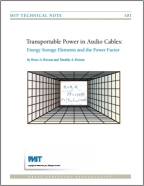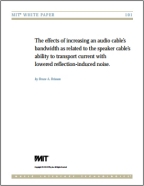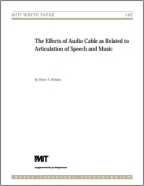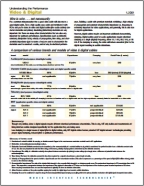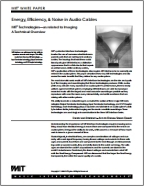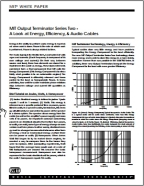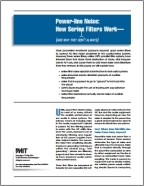MIT Whitepapers and Technical Writings
MIT Technical Note 101— Transportable Power in Audio Cables: Energy Storage Elements and the Power Factor
“For the past thirteen or fourteen years, since the first article in the audiophile press (by Jean Hiraga of France) pointed out the importance of the quality of cables in audio systems, the industry has been confused on the subject. For one thing, no industry standards exist for cables—let alone for the high end.”
MIT White Paper 101— The effects of increasing an audio cable's bandwidth as related to the speaker cable's ability to transport current with lowered reflection-induced noise.
“MIT constantly gets questions from the field regarding the ability of a cable to transport current between the amplifier and the speaker. Normally the question is, “What gauge wire do I need to hook up my 300 Watt amplifier to a given speaker?” Or, “Do I need bigger wire if my amplifier is 20 feet from my speakers rather…”
MIT White Paper 102— The effects of Audio Cable as Related to Articulation of Speech and Music.
“Our opinion at MIT is that customers should not have to spend money guessing what works best in their system. The installation / termination problem described above required MIT to engineer a solution. This engineered solution involves a technology we call Impedance Specific Networks, or ISN.”
Understanding the Performance of Video & Digital
“It’s a common misconception that a good video cable will also make a good digital cable. Take a high quality coax cable and terminate it with RCAs and you’re done. In video and digital cables (like audio cables) conductor materials and primary insulating (dielectrics) materials are very important. But there are many other characteristics that are also very important for…”
MIT White Paper— Energy, Efficiency and Noise in Audio Cables
“MIT’s patented interface technologies involve the use of numerous electrical component parts that are not found in ordinary cables. The housings that hold these additional parts give MIT Interfaces a distinctive appearance that is a first clue to their superior performance. Unlike ordinary cables, MIT’s application of these technologies also requires MIT Interfaces to be correctly…”
MIT White Paper— MIT Output Terminator Series II
“The music signal, in its electric form, is comprised of voltages and currents. (Each frequency is composed of its own voltage and current.) On their way between source and load, these two elements are stored for a short time in the cable as energy. These stored elements combined form a final component that MIT calls the Energy Component.”
Power Line Noise: How Series Filters work (and why they don't always)
“Most power-line treatment products depend upon series filters to correct AC line noise problems in the audio/video system. However, these series filters, unlike MIT’s parallel filter system, have inherent flaws that make them ineffective at many vital frequencies in A/V use and cause them to add more noise and distortions than they remove.”
MIT Tech Bulletin— AVI Video Cables
“It is a common misconception that a high quality video signal can be transported without distortion by a typical video cable. It sounds logical enough — that is until you think about what a complex task delivering that signal actually is.”

